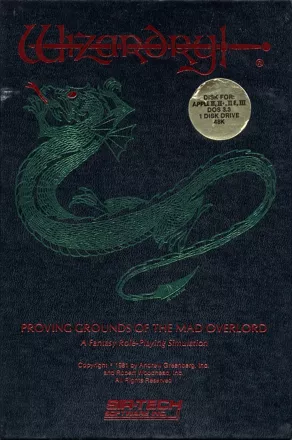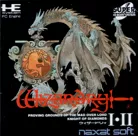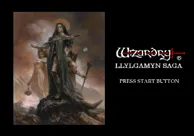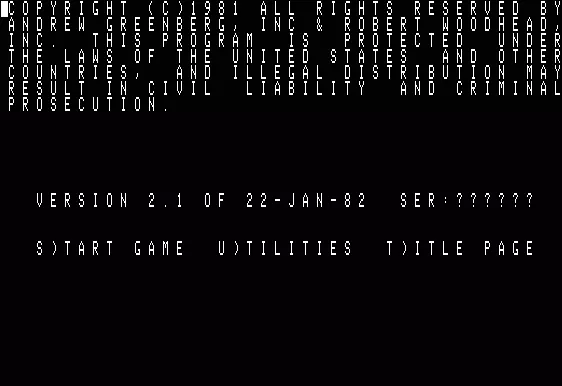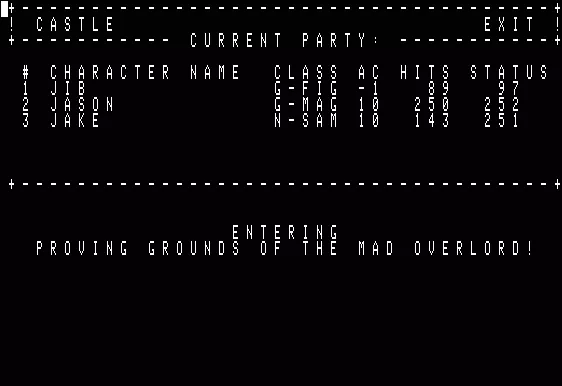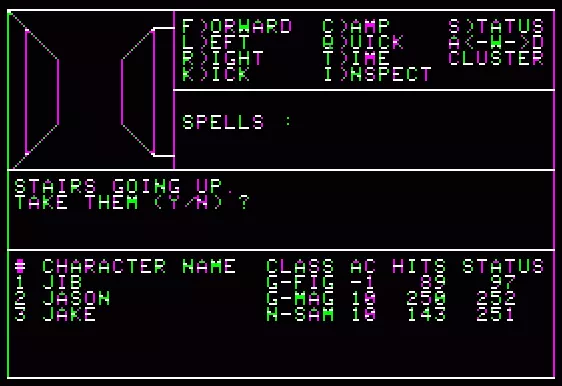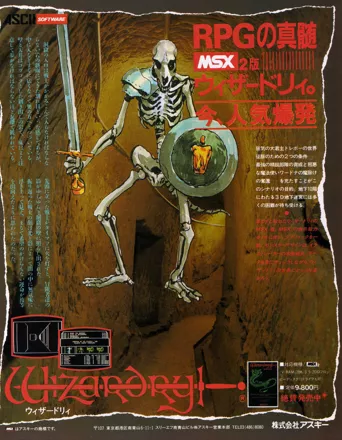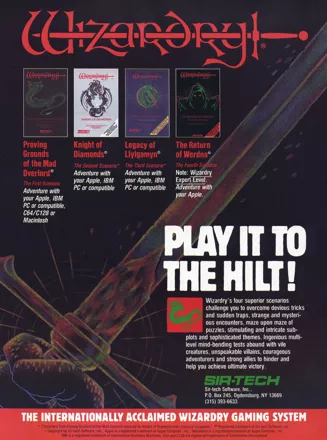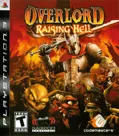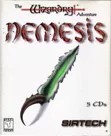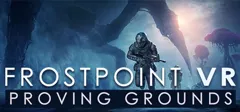Wizardry: Proving Grounds of the Mad Overlord
-
 Wizardry: Proving Grounds of the Mad Overlord
(2023 on
Windows)
Wizardry: Proving Grounds of the Mad Overlord
(2023 on
Windows)
Description official descriptions
The Mad Overlord Trebor was once only power-mad, but went off the deep end after he acquired a magical amulet of immense power, only to have it stolen from him by his nemesis, the evil archmage Werdna. Werdna, not quite sure how to use the amulet properly, accidentally causes an earthquake which creates a ten-level dungeon beneath Trebor's castle. To avoid looking silly, Werdna declares the dungeon to be the new lair for him and his monster hordes. Trebor, not to be outdone, declares the labyrinth his new Proving Grounds where adventurers must prove themselves for membership in his elite honor guard, and incidentally retrieve his amulet in the process.
The first Wizardry was one of the original dungeon-crawling role-playing games, and stands along with Ultima and Might & Magic as one of the defining staples of the genre.
The player generates and controls a party of up to six different adventurers, choosing from five races (humans, elves, dwarves, gnomes and hobbits), three alignments (good, neutral and evil), and four basic classes (fighter, priest, mage and thief). These can later evolve into elite classes (bishop: priest with mage spells; samurai: fighter with mage spells; lord: fighter with priest spells, and ninja: fighter with thief abilities) if they meet the necessary level requirements. After outfitting the party with basic weapons and armor, the player sends it into a 3D vector maze-like dungeon to fight monsters in turn-based combat and find treasure.
Spellings
- ウィザードリィ 狂王の試練場 - Japanese spelling
Groups +
- Fantasy creatures: Dragons
- Fantasy creatures: Dwarves
- Fantasy creatures: Elves
- Fantasy creatures: Gnomes
- Fantasy creatures: Halflings / Hobbits
- Fantasy creatures: Orcs
- Fantasy creatures: Trolls
- Gameplay feature: Character development - Automatic leveling
- Games made into books
- Genre: Dungeon crawler
- Wizardry games
Screenshots
Promos
Credits (Apple II version)
5 People
| By |
|
| Illustrations |
|
| Playtesting |
Reviews
Critics
Average score: 59% (based on 5 ratings)
Players
Average score: 3.6 out of 5 (based on 108 ratings with 5 reviews)
Classic, influential, and utterly obsolete.
The Good
Nobody doubts the tremendous and widespread influence of Wizardry. Unlike Dragon Warrior, it has a legitimate claim to being the first CRPG. Every time you play a modern first-person RPG like Morrowind or Oblivion, you’re playing a spiritual descendant of Wizardry. Maybe that’s enough to earn Wizardry its place in the Gaming Hall of Fame.
The NES conversion looks much better than the original Apple version of the game, replacing wireframe graphics with colored sprites and textures. The soundtrack loops incessantly, but it’s not too bad as these things go.
The Bad
Playing Wizardry now, it’s hard to believe that anyone was ever impressed with it. I suppose some folks really wanted to play D&D solo, and Wizardry (sort of) delivered. Otherwise, I can only chalk Wizardry’s popularity up to fascination with early home computers. After all, even programming a simple routine in BASIC was exciting back in 1981!
The production values are low by any standard. The NES port improves on the graphics of the original considerably, but it’s still light years behind console contemporaries Dragon Warrior, Final Fantasy, and Phantasy Star in the chrome department.
The user interface is cumbersome even for an NES port. It’s all text menus, which means it takes a long time to do anything, since you have to scroll through a bunch of lists first. After Final Fantasy let us “plug in” equipment into inventory slots, there’s just no good reason why we should need to go back to this tedious stuff. (It’s best not to even mention the spell system, which is downright inscrutable.)
Speaking of tedious…if you think Dragon Warrior is difficult, then don’t even think about playing Wizardry. This is the most sadistic game I have EVER played. Everything in this game kills you. I spent most of my time in Wizardry being trapped, lost, in the dark, poisoned, paralyzed, or just plain dead. Most of the gold you earn in the early going is spent resurrecting dead characters or equipping new replacement characters. This means you have little money left over for upgrading equipment, which means it’s hard to die with less frequency, which means you keep dying. It’s a bizarre mobius-strip approach to game design.
It wouldn’t be so bad if there was some kind of substance beneath all the layers of unfairness and frustration. Personally, I don’t see it. You’re a party of adventurers going down into a dungeon to explore and fight monsters, period. There is no story, no characters, and for all practical purposes, no locations. It’s just one big multi-story “dungeon,” which is nothing but a giant maze of passageways that all look alike. The only source of entertainment besides fighting is hand-mapping the maze on graph paper. But after the blessed invention of the automap, who in their right mind wants to go back to that kind of “fun”?
Wizardry is to CRPGs what the Velvet Underground is to rock music—everybody in the business claims to have been influenced by it, but nobody pays much attention to it anymore. That‘s probably because every RPG since 1985 surpasses it, in every way that matters. A great historical artifact, to be sure, but not much of a game.
The Bottom Line
Worth playing, but only for educational purposes. Feel free to give it a try for history’s sake—just be sure to wear your rose-tinted glasses.
NES · by PCGamer77 (3158) · 2008
One of the all time great RPG's
The Good
'Wizardry: Proving Grounds of the Mad Overlord' is an RPG game with simple graphics, simple sounds, and a wonderful atmosphere that has stood the test of time and remains an icon in RPG history.
The story behind this first installment is rather simple. It involves a party of adventurers venturing deep into a dungeon to destroy the evil wizard Werdna. The classic good vs. evil big bad guy is enough to get the game going. Getting there is half (if not all) of the fun, and the game is such a delight to play that I'll even go so far as saying that plot means little here. While most great RPG's are founded upon complex and involving storylines, Wizardry delivers a solid game playing experience without the benefit of a fancy story. A truely rare accomplishment, the game is that good.
The player basically begins by creating a party of adventurers to explore the 10 level maze adjacent to the 'town' where party building and maintenance takes place. This 'town' has no graphical interface, rather it is nothing but a text menu where the player is to select upon the establishment that he/she wishes to enter which brings upon another menu for options related to the establishment's services. While a text menu for in-town operations may seem archaic for some, it's good to know that the entirety of the excitement, adventure, and play time involve being in the maze. I prefer the text interface in town because your party only ventures there when they need to rest, buy and sell, or have various other services done. The text interface allows for these operations to be conducted in a very quick and efficient manner, allowing for the speedy return of your party back into what is the meat and potatoes of the game; the maze.
In town there are no quests to take upon, no people to talk to, and no real obligation to fulfill. Going to the surface is only for the purpose of resupply and maintenance of your party. As stated before, the game is focused on that one maze.
And yes, there is only one dungeon. This is part of what makes this game great. Many modern RPG's have multitudes of dungeons or places to explore, so how can one be excited about ONE place to go adventuring?
The answer is quite simple really; the dungeon is extremely complex, and takes quite some time to become familiar with. Once the player is familiar with the dungeon, he/she comes to know the area, and a level of focus begins to emerge. You are at war with this dungeon. It is a living, breathing thing and it's you vs. it. Because there is a lack of other dungeons, towns, or otherwise, Wizardry begins to show that it is a heads-up game, a 1v1 if you will. The maze is one big puzzle, and you must focus all of your energy on just this one place in hopes of coming out ahead. Only playing this game can really give the player this sense of understanding.
There are a variety of character classes and races to choose from, and to make things even better there really is no 'wrong way' to make a party. Players that take all kinds of approaches to party building can have success here. While some educated mixing and matching of classes would produce more powerful parties than going in blindly, just about any type of party you want to build has a chance at success. This freedom bestows a sense of power and control upon the player.
Classes range from Mages, Clerics, and Fighters, to Ninjas, Samurai, Thieves, and so forth. Creating a character involves selecting the race of a character (each races has particular base advantages and disadvantages for each statistic) and then the computer will give you some bonus points to spend on upgrading your new character's attributes. This number is random and can range from 5 to 19. In other words, you may have 5 points to spend upgrading your character's stats, or you may have 19. It is completely random and if you don't get the bonus points you desire, you can remove the character and create another until you are satisfied.
Character class is determined by where you put your bonus points. For example if you add enough points to strength, your character can become a fighter. Add enough points to piety, and your character has the option to become a cleric. Choosing the appropriate race for the type of character you wish to create is helpful as well, as a specific race may have a higher base statistic for the class you wish to create, requiring the player to spend less bonus points in order to select the desired class, and allowing for the remaining bonus points to be put into other statistics.
Once you have created your party, gone to the trading post and have purchased and equipped your wares, it's time to head off to the maze.
Let the excitement begin! A nice touch to the level design here is that once you enter the maze, you have a choice between two tunnels to begin walking through. The maze does have a first person interface, and on the NES the graphics are amazing when compared to the Apple II or C64 versions.
Walking around the maze, monsters cannot be seen until you are faced with the encounter. A message will pop up saying, 'An Encounter!' and at this point you are taken to a combat screen.
Combat is turn based and the player selects the appropriate course of action for each person in the party. Fighting, spell casting, using items, fleeing, parrying are all of the options (clerics get dispel undead as an option). It's important to be able to play each different class in your party to their best abilities. While there is no 'group attack' type thing as in the Final Fantasy games, the combat still takes teamwork and is best executed when there are participating classes that compliment one another's play styles.
Once monsters are dead experience and loot are rewarded. Most loot is delivered in a treasure chest that is usually trapped and requires a thief or ninja to disarm it. Most items are unidentified and require identification in town (usually). Some are cursed and equipping them may harm your character in some way. Once a cursed item is equipped, it is difficult to remove.
When enough experience is gained to level your characters up, you must return to town and rest at the Adventurer's Inn in order to complete the level up.
The maze is packed full of variety. While the maze starts out simple enough, very soon you'll find elevators, trapped rooms, rotating rooms, locked doors, secret doors, the works. It takes a fine balance of determination but also logistical practice to effectively explore the maze. Getting back to town should you be in a crisis is not simple if you're 6 levels down and are lost after being teleported by a trap or something of this nature. Instant travel back to town is a rarity, and the majority of the time going back to town requires walking back, fighting monsters the entire way. This aspect of the game adds a great level of excitement, because as you explore deeper, you get a sense of danger in that you are not likely to be able to instantly go back to town. Knowing when to turn back is key to survival. Waiting till members of your party are poisoned or dead is usually too late.
Wizardry is a very challenging adventure. There really is no save slot, and the game will tend to remember dead party members and such. If you have failure at a certain juncture, it's not as easy as reloading a save file and trying again. If your party wipes, it might be necessary to create new characters to go into the maze to retrieve bodies. The longer you wait, the less likely you are to find them and the bigger the possibility that items or money is missing on your poor adventurers.
I had even tried a quick reset on the NES when I died in order to avoid this problem. When I started the game up again, it remembered that my party is wiped out. This inability to really cheat forces the player to play the game on the designer's terms, which in turn makes the player carefully consider all of their actions. Good stuff.
I would like to discuss the maze more at length as there is so many great innovations to level design, but for fear of creating too many spoilers, it will be up to you to discover these nice touches to a mysterious and exciting dungeon crawler.
The Bad
There wasn't much I disliked about wizardry. I will say however that the biggest annoyance was that all of the spells are in a made up language, resembling some sort of gibberish. For example, a spell that induces sleep is called 'Katino'. The 'Calfo' spell is used inspect treasure chests, and 'Lomilwa' is a light spell that also shows hidden doors. Either documentation of spell effects or trial and error is the only way to learn what these spells do.
WARNING TO NES USERS: The wizardry game pak for the NES saves games by operating on a battery installed within the game pak. These batteries typically last between 3 and 5 years, and being that this game was published for the NES in 1987 (19 years ago at the time of this review), there are no game paks in existence that are capable of saving your game. Emulation with saved states is an option for the tech-savvy that is serious about this game.
The Bottom Line
Wizardry: Proving Grounds of the Mad Overlord is a fantastic game, and the series has succeeded all the way to an eighth installment. Give it a chance and you'll be hooked. While technology has produced games that eventually came to outgrow the simplicity of Wizardry, I have to admit that for its time this game was truly remarkable. One of my all time favorites. Now fight, fight, fight, parry, parry, parry!
For more detailed information on Wizardry, visit http://www.lava.net/~jh/wizardry/wizardry.html
This site has EVERYTHING you could possibly want to know, including maps. Be careful if you like surprises though, there are many spoilers at that site.
NES · by D Michael (222) · 2006
Landmark RPG in computer gaming
The Good
This is the first computer role playing game I ever purchased. Actually, one of the main reasons I pestered my parents into buying me an Apple II was so I could play this game. It cost me $50 in 1983, which is over $90 today. The disk drives that came with my second-hand Apple weren't up to reading the sensitive Wizardry disks, so I had to get them repaired first.
But all the headache was worth it. I was a big D&D fan, but living up in the sticks, I rarely had anyone nearby to play with. This game was a great solution to this problem. Not only was I amazed by the flashy opening animation, I was enthralled by the gameplay. While the graphics were crude and splotchy by today's standards, they amazed me in 1983! There was a graphic representation of the actual monster I was fighting! Right there in front of me! Of course it was static--it wasn't animated--but I didn't have to remember what it looked like. There it was! I was fighting an orc! A skeleton! A slime! Woo-hoo!
And for the first time, I could actually see the dungeon from the point of view of my characters! The dungeons were rendered as crude line drawings, but in the 1980s, that was state of the art! Not even the staircases were rendered, but that didn't matter. There were the walls in blotchy Apple II "white." How could it get any better?
Though it wasn't strictly D&D, it was close enough for my tastes. Though it was just one dungeon, it was enough to satisfy my desire to role-play.
Wizardry allowed to user to carefully orchestrate his party's attack, just like all early paper role-playing games. And the party could consist of several adventurers of different classes (mages, fighters, clerics, etc.). Where in D&D I had to role all my own dice, the computer now took care of it for me, showing me my virtual "roll" versus the enemy's. While sometimes I groaned over the result, I couldn't argue that it wasn't fair. After all, it displayed my result, right there in front of me.
While I never finished this game, it gave me endless pleasure in role-playing alone or impressing envious friends.
While it was far outdone by later games (notably The Bard's Tale), Wizardry launched the genre and remains one of the most important computer role-playing games in the history of video gaming.
The Bad
Wizardry, like many early home computer games, was pretty unforgiving to the user. The player could only have one active game, and there was no way to prevent your party from getting killed when outmatched in a fight, or to back up and retry a battle. Once your party got killed, they really got killed! And the game was pretty merciless about saving the data to disk. If you pulled out the disk so it couldn't save the information that your party got killed (as I did on many occasions), there was a good chance that your copy of the game would become corrupted. Even though they warned not to remove the disk, I and many other players did, so as not to lose scores of hours of adventuring. The only way to recover the disk was to mail it back to Sir-Tech for repairs.
The Bottom Line
A great landmark computer RPG. Outdone by successors, but unmatched when it came out. Worth a look for any video game aficionado.
Apple II · by Frecklefoot (188) · 2007
Discussion
| Subject | By | Date |
|---|---|---|
| Why a dragon on the cover? | Scribblemacher (195) | Sep 6, 2012 |
| how to use flopper and activate a scenario disk | unit | Aug 3, 2007 |
Trivia
Andrew Greenberg, Inc. vs Sir-tech Software, Inc.
Back in 1979 Andrew Greenberg, Inc. created the name, concept and plot for a computer fantasy role-playing game "Dungeons of Despair", released two years later by Sir-tech Software, Inc. as "Wizardry". Both corporations entered into an agreement granting Siro-tec the right to manufacture and market Wizardry, related products and any subsequent versions of the game in exchange of a payment of license royalty fee and a percentage of gross sales revenues. However, after success of the first Wizardry game release, Sir-Tech stopped sending royalty payments and accounting statements to Andrew Greenberg, Inc.
In 1992 Andrew Greenberg, Inc. sued Sir-tech Software, Inc for not paying royality fee, breach of contract, trade secret misappropriation and tortious interference, starting a long term (3 decades) lawsuit, resolved after Sir-tech bankruptcy.
Bugs
There is a famous bug in Wizardry that gives players a large number of experience points if you type an item number that's not on the numbered list when having your party's bishop identify them. When the PC version finally arrived years after the Apple II release, the programmers intentionally left the bug in to be "fair" to PC players.
The NES version of the game features a bug involving the Armor Class statistic. While the characters can change their armor class by equipping different items and the character screen reflects it, the statistic is not used in combat calculations.
Code
Wizardry is written in Pascal. Several instances of code appear sprinkled throughout the diskette (they probably mastered it on a diskette they had not fully erased). For example:
```
BEGIN MoveLeft(S^.Dat a,Info,1+Ord(S^.Data[0])); Exit(GetStr) END; blk:=KN DIV 256+SoffSet; offset:=2(KN MOD 256); C:=CheckCache(dHead,dTail,blk); (strOffsets^[strTree^[lastTree].iindexOffset+[lastTree].startIndex]); Info:='ERR*' END;
PROCEDURE PlotStr; VAR S:Str255; BEGIN
FOR i:=0 TO numInParty-1 DO
BEGIN
BigAdd(totGold,Party[i].Gold); Party[i].Gold:=noGold; END;
Party[N].Gold:=totGold END;
```
Development
According to Andrew Greenberg, the prototype Wizardry was created because of a challenge Greenberg accepted at college to create a computerized version of D&D. He later teamed up with Robert Woodhead to improve the game for commercial release.
Extras
The PC version of Wizardry came out three years after the original Apple version, and those three years gave wisdom to Sir-Tech. Users of the original PC version were treated to the following (extensive!) materials:
- Player's Guide (manual)
- Playing Wizardry On Your IBM PC & PCjr (PC-specific guide)
- Instructions and Briefing Materials (an overview of the story)
- A notice on backing up your master disk to a scenario disk
- A note from the authors asking that the user not use "cheat programs"
- Tips on Keeping Your Computer Healthy
- Map Plotting Aid
Notes:
- The "map plotting aid" was a small pad of graph paper--with the first page printed as a partial map of level 1 to get you started!
- The Tips on Keeping Your Computer Healthy were presumably added to help keep generic PC support calls to a minimum. (Back in 1984, there weren't many places to turn to for tech support.)
- The special note from Andrew and Robert was not to politely ask the user not to copy the software illegally, but instead asked that the user not use cheat codes to ruin the playing experience!
The Tips on Computer Care and the Note to Users are reproduced below for historical significance:
<hr />Tips on Keeping Your Computer Healthy
We hope you are getting a byte or two out of your computer each day. Here are a few tips on prolonging the life of your software.
Clean Your Disk Drives
Cleaning your disk drives takes only a few minutes and makes them work better. Clean your drives every second week.
Get Your Drives Tuned
A majority of disk problems are caused by misaligned disk drives. Your most valued software could be damaged. So protect your investment—get your drives aligned and speed adjusted at least twice a year at your dealer.
Protect Your Computer’s Power
Computers like a steady power supply. However, large appliances or equipment send spikes down a power line. These power spikes cause memory glitches and can alter software if you were writing to the disk when a transient happened. A surge suppressor such as a Blitz Bug will prevent power surges. At $25 to $50, they are a good investment.
Follow these tips and you will probably never have a problem with your software. Our experience has been that at least 97% of reported software problems are caused by unmaintained computers. Your dealer is in business to support you. If you have any questions, go see him, he will be happy to help you.
Dear Wizardry Purchaser:
Thank you for acquiring the most widely acclaimed game program for the micro-computer. It’s popularity is attested to by Wizardry’s long term standing as the number one program of its class. Among the reasons for Wizardry’s great standing is its exceptional long term playing value.
It has come to our attention that some software vendors are marketing so-called “cheat programs”. These products allow you to create characters of arbitrary strength and ability.
While it may seem appealing to use these products, we urge you not to succumb to the temptation. It took more than four years of careful adjustment to properly balance Wizardry. These products tend to interfere with this subtle balance and may substantially reduce your playing pleasure. It would be akin to playing chess with additional queens, or poker with all cards wild.
It has also come to our attention that some of these programs are unreliable and may even destroy the data. While we repair or replace inoperative disks free within 30 days of purchase, or for a nominal fee of $5.00 anytime thereafter, we will not do so for disks damaged by a cheat program.
With kind regards and our best wishes for many, many hours of fun and pleasure.
Yours truly,
(signatures of Andrew Greenberg and Robert Woodhead)
Innovations
Wizardry is generally credited as the first computer RPG to feature parties of multiple characters instead of a lone hero/adventurer.
PC version
The PC version of Wizardry went through several revisions from 1984 to 1987, incrementally fixing bugs and increasing compatiblity with PC clone hardware. Around 1988, Sirtech release a compilation package with several Wizardrys, and the entire graphics subsystem was redone to have redrawn PC-specific graphics (the first PC version used roughly-converted graphics from the original Apple version).
References
The names of the two major characters are actually the names of the game's two creator's spelled backwards, Andrew "Werdna" Greenberg and Robert "Trebor" Woodhead.
Awards
- Computer Gaming World
- March 1988 (Issue #45) – Introduced into the Hall of Fame
- November 1996 (15th anniversary issue) - #16 in the “150 Best Games of All Time” list
- GameSpy
- 2001 – #21 Top Game of All Time
Information also contributed by Adam Baratz; jef leyda, PCGamer77, Trixter and Ye Olde Infocomme Shoppe
Analytics
Upgrade to MobyPro to view research rankings!
Related Sites +
-
Making Wizardry
An article about the development of the game on The Digital Antiquarian (English) -
Prepare Yourself For the Ultimate in Fantasy Games
An extremely comprehensive site with maps, walkthroughs, and information about the entire Wizardry series. -
Wizardry1: Proving Grounds of the Mad Overlord
A site dedicated solely to Wizardry 1. Contains lots of comprehensive information including maps, documentation, and Apple ][ emulation.
Identifiers +
Contribute
Are you familiar with this game? Help document and preserve this entry in video game history! If your contribution is approved, you will earn points and be credited as a contributor.
Contributors to this Entry
Game added by Alan Chan.
Commodore 128 added by Trypticon. PC Booter added by Trixter. NES added by PCGamer77. Game Boy Color added by Ƒreddƴ. Apple II added by KnockStump. Macintosh added by be34269. FM-7, Commodore 64, PC-98, PC-88 added by Terok Nor. WonderSwan Color added by Игги Друге. Sharp X1, MSX added by Unicorn Lynx.
Additional contributors: Unicorn Lynx, Kabushi, Pseudo_Intellectual, formercontrib, Donatello, Patrick Bregger, Karsa Orlong.
Game added March 28, 2000. Last modified March 26, 2024.
